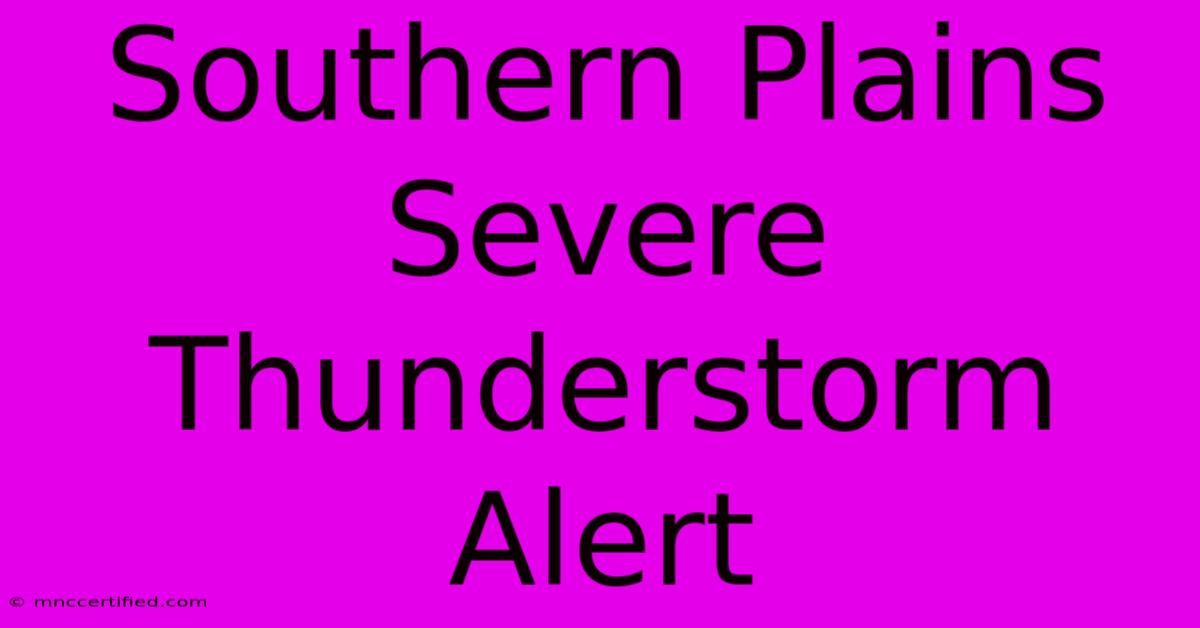Southern Plains Severe Thunderstorm Alert

Table of Contents
Southern Plains Severe Thunderstorm Alert: Staying Safe During Severe Weather
The Southern Plains region of the United States is a hotbed for severe thunderstorm activity. Understanding the risks and knowing how to prepare is crucial for staying safe. This comprehensive guide will cover everything you need to know about Southern Plains severe thunderstorm alerts, including what to expect, how to prepare, and what to do during and after a storm.
Understanding the Threat: Southern Plains Severe Weather
The Southern Plains, encompassing parts of Texas, Oklahoma, Kansas, and New Mexico, are particularly vulnerable to severe thunderstorms due to a unique combination of geographical and meteorological factors. These include:
-
The "Tornado Alley" effect: The convergence of warm, moist air from the Gulf of Mexico and cold, dry air from the Rocky Mountains creates atmospheric instability, leading to the formation of supercell thunderstorms – the most dangerous type, capable of producing tornadoes, large hail, and damaging winds.
-
High temperatures and humidity: The intense summer heat fuels the atmosphere, providing ample energy for thunderstorm development.
-
Dryline interactions: The boundary between dry and moist air masses often acts as a trigger for severe thunderstorm development. This dryline, common in the Southern Plains, can be a significant factor in storm intensification.
Types of Severe Weather Threats in the Southern Plains:
- Tornadoes: These violently rotating columns of air are a major threat, capable of causing widespread destruction.
- Large Hail: Hailstones larger than 1 inch in diameter can damage property, injure people, and kill livestock.
- Damaging Winds: Straight-line winds exceeding 58 mph (93 km/h) can cause significant damage to structures and uproot trees.
- Flash Flooding: Heavy rainfall in a short period can lead to rapid rises in water levels, causing dangerous flash floods.
Staying Informed: Severe Thunderstorm Watches and Warnings
The National Weather Service (NWS) issues watches and warnings to alert the public about potential and imminent severe weather. Understanding the difference is crucial:
-
Severe Thunderstorm Watch: This means conditions are favorable for severe thunderstorms to develop. Stay informed and be prepared to take action if a warning is issued.
-
Severe Thunderstorm Warning: This means a severe thunderstorm has been spotted by weather radar or reported by spotters. Take immediate action to protect yourself and your property. Seek shelter immediately.
Preparing for Severe Thunderstorms in the Southern Plains
Preparation is key to minimizing the risk of severe weather damage and injury. Here's what you should do:
- Develop a safety plan: Identify safe places in your home and designate a meeting point for your family in case of separation.
- Assemble an emergency kit: Include water, non-perishable food, flashlights, batteries, a first-aid kit, medications, and important documents.
- Monitor weather forecasts: Regularly check the NWS website, weather apps, or local news for updates.
- Sign up for weather alerts: Many weather services offer text or email alerts for your specific location.
- Know your surroundings: Identify potential hazards in your area, such as flood-prone areas or weak structures.
What to Do During a Severe Thunderstorm
When a severe thunderstorm warning is issued, immediate action is necessary:
- Go inside a sturdy building: If possible, move to an interior room on the lowest level, away from windows.
- Avoid windows and doors: These are the most vulnerable points during severe weather.
- Stay away from water: Flash floods are a significant danger during severe thunderstorms.
- Unplug electronic devices: Lightning strikes can damage electronics.
- If outdoors, seek immediate shelter: If you are caught outdoors, find shelter in a sturdy building, a vehicle, or a low-lying area away from trees.
After the Storm: Safety and Recovery
After the storm has passed, it's important to assess the damage and take the necessary steps for recovery:
- Check for injuries: Provide first aid if needed and contact emergency services if necessary.
- Inspect your property: Look for structural damage, downed power lines, and other hazards.
- Report damage: Contact your local authorities to report any damage to your property or infrastructure.
- Be aware of lingering dangers: Flooding, downed power lines, and debris can pose significant risks even after the storm has passed.
By understanding the risks, preparing adequately, and taking appropriate action, you can significantly reduce the impact of severe thunderstorms in the Southern Plains. Remember, safety is paramount. Stay informed, stay prepared, and stay safe.

Thank you for visiting our website wich cover about Southern Plains Severe Thunderstorm Alert. We hope the information provided has been useful to you. Feel free to contact us if you have any questions or need further assistance. See you next time and dont miss to bookmark.
Featured Posts
-
Minor Quakes Reported Near Fontana
Nov 18, 2024
-
Unexpected I M A Celeb Bond Barry
Nov 18, 2024
-
England Vs Ireland Match Stream And Result
Nov 18, 2024
-
Get To Know Gk Barry Age And More
Nov 18, 2024
-
Kittle Misses Seahawks Game Injury Update
Nov 18, 2024